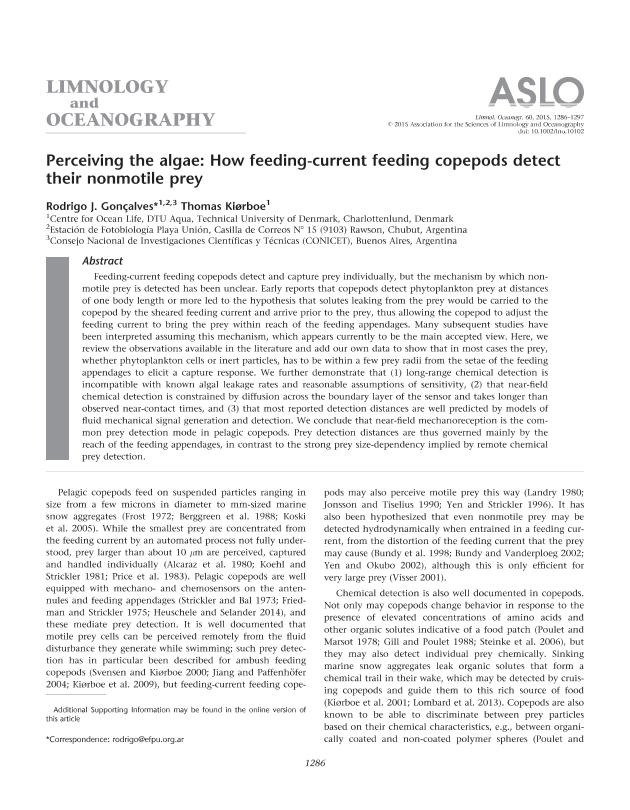Artículo
Perceiving the algae: How feeding-current feeding copepods detect their nonmotile prey
Fecha de publicación:
03/2015
Editorial:
American Society of Limnology and Oceanography
Revista:
Limnology and Oceanography
ISSN:
1939-5590
Idioma:
Inglés
Tipo de recurso:
Artículo publicado
Clasificación temática:
Resumen
Feeding-current feeding copepods detect and capture prey individually, but the mechanism by which nonmotile prey is detected has been unclear. Early reports that copepods detect phytoplankton prey at distances of one body length or more led to the hypothesis that solutes leaking from the prey would be carried to the copepod by the sheared feeding current and arrive prior to the prey, thus allowing the copepod to adjust the feeding current to bring the prey within reach of the feeding appendages. Many subsequent studies have been interpreted assuming this mechanism, which appears currently to be the main accepted view. Here, we review the observations available in the literature and add our own data to show that in most cases the prey, whether phytoplankton cells or inert particles, has to be within a few prey radii from the setae of the feeding appendages to elicit a capture response. We further demonstrate that (1) long-range chemical detection is incompatible with known algal leakage rates and reasonable assumptions of sensitivity, (2) that near-field chemical detection is constrained by diffusion across the boundary layer of the sensor and takes longer than observed near-contact times, and (3) that most reported detection distances are well predicted by models of fluid mechanical signal generation and detection. We conclude that near-field mechanoreception is the common prey detection mode in pelagic copepods. Prey detection distances are thus governed mainly by the reach of the feeding appendages, in contrast to the strong prey size-dependency implied by remote chemical prey detection.
Palabras clave:
ZOOPLANKTON
,
PREY CAPTURE
,
FEEDING
,
PREY DETECTION
Archivos asociados
Licencia
Identificadores
Colecciones
Articulos(SEDE CENTRAL)
Articulos de SEDE CENTRAL
Articulos de SEDE CENTRAL
Citación
Gonçalves, Rodrigo Javier; Kiørboe, Thomas; Perceiving the algae: How feeding-current feeding copepods detect their nonmotile prey; American Society of Limnology and Oceanography; Limnology and Oceanography; 60; 4; 3-2015; 1286-1297
Compartir
Altmétricas




